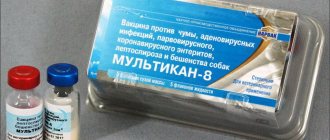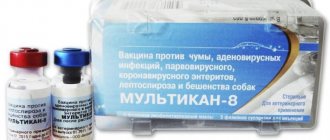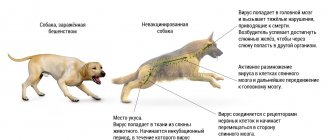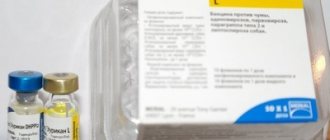Dogs have always been and remain one of their most beloved pets; for many centuries they have served people faithfully. Unfortunately, they also get sick sometimes. Often these illnesses turn out to be very serious, threatening the life of the animal. And to prevent this from happening, their caring owners come to the rescue. They are concerned that their pet is vaccinated on time and that the most optimal option is chosen with maximum effectiveness and a minimum of side effects. One of these products is the Multikan vaccine from domestic manufacturers.
Biological properties
The Multikan-4 vaccine causes the formation of an immune response in dogs to plague, adenovirus infection, parvovirus and coronavirus enteritis 2-3 weeks after immunization, lasting 6-8 months in young animals, 12-15 months in adults.
One immunizing dose of the vaccine contains at least:
- canine distemper virus - 10*3.5TCD50
- canine adenovirus type 2 - 10*3.0TCD50
- canine parvovirus - 10*3.0 GAU
- canine coronavirus - 10*3.0TCD50
The vaccine is harmless and areactogenic and has no medicinal properties.
Contraindications and side effects
The use of Multikan-4 is contraindicated:
- weakened and sick animals;
- pregnant dogs in late gestation;
- dog in the first 30 days after birth.
No side effects or complications were identified during vaccination with Multikan-4.
Dogs with hypersensitivity to medications may experience a mild and allergic reaction, the symptoms of which disappear when taking any antihistamines (relieving allergy symptoms).
Doses and method of administration
The Multikan-4 vaccine is administered:
- puppies twice at 8-10 weeks of age and after 21-28 days intramuscularly or subcutaneously in the neck area in a dose of 2.0 ml immediately after dissolution. Revaccination of puppies is carried out at the age of 10-12 months;
- dogs of small and decorative breeds are immunized at a dose of 1 ml;
- adult dogs are vaccinated once a year at a dose of 2 ml.
Before use, the vaccine is heated to a temperature of 36-38°C; during use, the vials with the vaccine are thoroughly shaken. Before use, the lyophilized vaccine component is dissolved in 2 ml of the supplied solvent.
Vaccine Multikan-4 for dogs (1 dose/2 fl. liquid + dry component)
DESCRIPTION
Multikan-4 is a vaccine against distemper, adenoviral infections, parvovirus and coronavirus enteritis in dogs. In appearance, the lyophilized component is a dry, homogeneous, finely porous mass of yellow-pink color. The liquid component is a colorless transparent liquid.
COMPOUND
The dry component – lyophilized mass – is made from attenuated industrial strains of canine distemper virus, canine adenovirus type 2, parvovirus and canine coronavirus with a drying medium; liquid component – water for injection.
BIOLOGICAL PROPERTIES
The Multikan-4 vaccine causes the formation of an immune response in dogs to plague, adenovirus infection, parvovirus and coronavirus enteritis 2-3 weeks after immunization, lasting 6-8 months in young animals, 12-15 months in adults.
One immunizing dose of the vaccine contains at least: canine distemper virus - 103.5 TCD50, canine adenovirus type 2 - 103.0 TCD50, canine parvovirus - 103.0 GAE, canine coronavirus - 103.0 TCD50.
The vaccine is harmless and areactogenic and has no medicinal properties.
DOSAGE AND APPLICATION
The Multikan-4 vaccine is intended for the prevention of distemper, adenovirus infections, parvovirus and coronavirus enteritis in dogs.
The Multikan-4 vaccine is administered to puppies twice at 8-10 weeks of age and after 21-28 days intramuscularly or subcutaneously in the neck area in a dose of 2.0 ml immediately after dissolution.
Revaccination of puppies is carried out at the age of 10-12 months.
Dogs of small and decorative breeds are immunized at a dose of 1 ml.
Adult dogs are vaccinated once a year at a dose of 2 ml.
Before use, the vaccine is heated to a temperature of 36-38°C; during use, the vials with the vaccine are thoroughly shaken.
Before use, the lyophilized vaccine component is dissolved in 2 ml of the supplied solvent.
Vaccination is carried out in compliance with the rules of asepsis; only sterile materials and instruments are used for injection. A separate needle is used for each animal.
SPECIAL INSTRUCTIONS
No symptoms of plague, adenoviral infections, parvovirus and coronavirus enteritis or other pathological signs were identified with an overdose of the vaccine.
Features of the post-vaccination reaction during primary and subsequent vaccinations have not been established.
Violations of the vaccination schedule (timing) should be avoided, as this can lead to a decrease in the effectiveness of immunoprophylaxis for distemper, adenoviral infections, parvovirus and coronavirus enteritis in dogs. If the next dose of vaccine is missed, immunization should be carried out as soon as possible.
CONTRAINDICATIONS
It is prohibited to vaccinate clinically sick and/or weakened animals and dogs in the last month of pregnancy and in the first month after birth.
SIDE EFFECTS
When using the vaccine in accordance with these instructions, side effects and complications, as a rule, are not observed. A quickly disappearing swelling may appear at the injection site. If some animals exhibit allergic reactions to the introduction of the vaccine, antihistamines are used.
SHELF LIFE AND STORAGE
The shelf life of the vaccine is 18 months from the date of release, subject to storage and transportation conditions. After the expiration date, the vaccine is not suitable for use.
The vaccine is stored and transported in a dry, dark place at a temperature of 2°C to 8°C. Should be stored out of the reach of children.
PACKAGE
The dry and liquid components of the vaccine are packaged in 1.0 ml (1 dose) bottles or ampoules with a capacity of 3.0 ml. The vials are sealed with rubber stoppers reinforced with aluminum caps, the ampoules are hermetically sealed. The vials (ampoules) with the vaccine are packaged in cardboard (plastic) boxes or blisters. Each box of vaccine contains instructions for its use.
special instructions
- Vaccination is carried out in compliance with the rules of asepsis; only sterile materials and instruments are used for injection. A separate needle is used for each animal.
- Violations of the vaccination schedule (timing) should be avoided, as this can lead to a decrease in the effectiveness of immunoprophylaxis for distemper, adenoviral infections, parvovirus and coronavirus enteritis in dogs. If the next dose of vaccine is missed, immunization should be carried out as soon as possible.
- The vaccine is not used in the same syringe with other biological products and drugs, and also within 7 days after deworming and 14 days after treatment with chlorine- and phosphorus-containing drugs.
Composition and release form
"Multican-4" refers to effective preventive and non-hazardous drugs for the treatment of diseases caused by paramyxoviruses, adenoviruses (type II), parvoviruses and coronaviruses.
The form of the medicinal product is represented by two components:
- dry - softly dried (lyophilized) bacteria (1.0 ml) in the form of a yellow mass with a high level of solubility;
- liquid - sterile distilled water for injection (2.0 ml).
Personal prevention measures
- When working with the vaccine, you should follow the general rules of personal hygiene and safety precautions provided for when working with veterinary medicinal products.
- All persons participating in vaccination must wear special clothing (robe, trousers, hat, rubber gloves). Places of work must have a first aid kit.
- If the vaccine gets on the skin and/or mucous membranes, it is recommended to rinse them with plenty of tap water.
- In the event of a vaccine spill, fill the contaminated area of the floor with a 5% solution of chloramine or sodium hydroxide.
- If the drug is accidentally administered to a person, the injection site must be treated with a 70% solution of ethyl alcohol, contact a medical facility and inform the doctor about this.
Side effects and contraindications
It is strictly contraindicated to administer the vaccine to animals that have clinical signs of plague, enteritis or adenovirus. You should also not vaccinate dogs that have recently suffered a serious illness.
When administered to healthy animals, no side effects are observed. A small painless swelling may appear at the injection site, which will resolve within 1-2 hours.
In rare cases, an individual allergic reaction may occur; in this case, the pet should be given an antihistamine (suprastin, diphenhydramine, etc.).
To monitor the condition of the animal and the vaccination period, special stickers are included with the vaccine.
Vaccination stages
Vaccination should occur in several stages:
- Dilution of the drug. The vaccine should be checked to ensure it was properly transported and stored at the temperature stated on the label. After mixing, draw the solution into a syringe and remove excess air bubbles by tapping on the side of the syringe. The needle should be pointing upward.
- Preparing your pet. You should make sure that the dog is clean and there is no visible dirt on the skin around the neck. You need to lift some of your pet's skin near the neck to pinch. This will provide a certain space under the skin where the drug can be injected.
- Carrying out the injection. You should carefully pierce the skin with a needle and insert a syringe. Slowly pressing the plunger of the syringe, inject the Multikan 4 vaccine.
Attention! If blood is visible in the needle, then you need to find another place to inject. This means that there was a hit in a blood vessel, and you cannot inject there.
- Removing the needle. As soon as the needle is pulled out, you need to press your fingers on the injection site and hold them for about 30 seconds. This will prevent bleeding. Place the needle and syringe in an appropriate waste container or glass jar, which should be disposed of at the veterinary clinic.
Possible adverse reactions
As with any medical procedure, there is a small chance of side effects. In most cases, the risks are much less than the incidence of the disease itself. Most dogs respond very well to the drug, but serious side effects or allergic reactions of varying severity are possible. In case of negative symptoms, you should contact your veterinarian.
The reasons for the negative consequences of vaccination are very common:
- incorrect injection or incorrect vaccination schedule;
- hypersensitivity to the components of the drug;
- weak immune system of the animal.
In case of negative symptoms, it is necessary to contact a veterinarian, as there are various acute reactions leading to death.
The most common side symptoms are:
- apathy;
- lethargy;
- loss of appetite;
- fever;
- vomiting and diarrhea;
- pain at the injection site;
- abscess;
- mouth swelling and drooling;
- aggressiveness;
- local irritation;
- abnormal coordination.
If your dog experiences any of these signs, you should contact your veterinarian and ask for a change in vaccine in the future. It should be emphasized that very severe allergic reactions occur relatively rarely.
Owner reviews
Svetlana, mistress of the mestizo:
“I found a puppy of an unknown breed on the street, about 8 weeks old. My dog died of distemper a month ago, so I decided to get vaccinated right away. The pharmacy recommended Multikan 4 for four viruses. The puppy tolerated the vaccination well, there were no side effects.”
Andrey, border collie owner:
“I vaccinated my puppy Flik with the drug Multikan 4 at the veterinary clinic. There are also Multikan 6 and 8 from six and eight viruses, but the doctor said that this is too much of a burden on the puppy’s body. Flick tolerated the procedure well. True, there was a little diarrhea, but everything went away quickly.”
Arina, poodle owner:
“We recently got ourselves a poodle. We don’t understand anything about vaccination and nutrition of dogs, so we went to the veterinarian, who recommended that we get vaccinated with Multikan 4. He said that the product was excellent and inexpensive. We trusted him and got the first vaccination at one and a half months, and again after a certain period of time. Our Betsy tolerated both vaccines well, only she slept more than usual. The main thing is to give an anthelmintic seven days before vaccination, not introduce anything new into the diet, and everything will be fine.”
Why you need to immunize your dog
Four-legged pets must be vaccinated regardless of age in order to protect them from many dangerous diseases or alleviate pathological conditions. Before vaccination with Multikan 4, you should consult with your veterinarian and determine which viruses you should protect your pet from.
In the case of canine distemper, both young and old individuals are most at risk. The disease affects the respiratory, digestive and nervous systems, and the mortality rate for infected pets is quite high.
Parvovirus and coronavirus manifest as bloody diarrhea and weakness. Timely treatment offers a good chance of recovery for adult dogs, but therapy is lengthy. These diseases are often fatal for young animals.
Adenoviral infections are accompanied by cough and inflammation of the respiratory system. Despite the fact that these phenomena pass, the disease can lead to irreversible damage to the four-legged pet's lungs.








